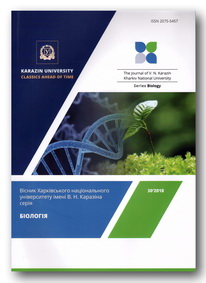Засоби діагностики першопричин виникнення десинхронозів у студентів, які професійно займаються спортом
Анотація
Структура біологічного ритму найбільш чутлива до перетворень, які виникають при зміні звичних умов життя, тому автори роботи присвятили увагу вивченню базових його параметрів, а саме аналізу добового режиму дня з урахуванням циклів «бадьорості та сну», індексу якості сну, ступеню вираженості безсоння, які безпосередньо впливають на працездатність людини та результат її спортивної діяльності. Авторами роботи розроблено систему електронної діагностики біоритмів людини, яка розташована на відкритих освітніх ресурсах ХНУ імені В.Н.Каразіна. В роботі вперше оцінено базові цикли «бадьорості та сну», «активності та спокою» як базові цикли режиму дня студентів, які професійно займаються спортом, за допомогою засобів електронної діагностики. В роботі визначено індекс вираження безсоння, який впливає на психосоматичний стан та може бути безпосередньою причиною порушення динамічного стереотипу людини, погіршення самопочуття, що сприятиме розвитку десинхронозів. Отримані дані вказують на те, що обстежена група осіб може достатньо легко пристосуватися до навантажень, як у вечірні, так і в ранкові години, однак, імовірно, ці особи мають неприродні типи добової працездатності, які в свою чергу є проявом адаптації до нових умов існування. Також дана група осіб характеризується середніми та високими показниками якості сну та відновлення організму. Особам даної групи легше заснути в нестандартних умовах, аніж пильнувати у нехарактерні години доби. Сучасна молодь, незважаючи на активний (спортивний) спосіб життя, має певні порушення в тривалості та характері сну. Отримані дані свідчать про те, що зменшення тривалості сну на 1,3–1,5 год здійснює вплив на стан бадьорості та активності протягом дня. Незважаючи на те, що хронічного недосипання в даній групі студентів, які займаються професійним спортом, не виявлено, встановлено індивідуальні варіації потреби у кількості сну, а після тривалого сну спостерігається мінімальне покращення буденного пильнування, зменшення втомлюваності, покращення процесів пам’яті, сприйняття та концентрації уваги, що безпосередньо впливає на спортивний результат. Компенсація нічного недосипання можлива переважно лише за рахунок більш тривалих перерв протягом дня. Таким чином, потреба у сні визначається, з одного боку, процесами послаблення та втоми, які наростають під час бадьорості, та циркадним процесом, циклом «активності та спокою». Рівень потреби у сні збільшується під час бадьорості та зменшується під час сну, в той час як циркадний ритм є незалежним компонентом, який знаходиться під контролем внутрішнього біологічного годинника. Отже, потреба у сні в кожний конкретний момент є сумацією процесів «активності та спокою», «бадьорості та сну» та внутрішнього біологічного годинника, а порушення у взаємодії цих процесів пояснюють суб’єктивні переживання, пов’язані із порушенням добового ритму при різкій зміні режиму дня та зміни тривалості світлового дня. Тому коли час засипання припадає на період активності і людина не може заснути, а вдень відчуває постійну сонливість внаслідок наростаючої потреби у сні – це і є порушення циклу «бадьорості та сну», пов’язані із новими умовами існування та стресовими навантаженнями на організм.
Завантаження
Посилання
Агаджанян Н.А., Башкиров А.А., Власова И.Г. О физиологических механизмах биологических ритмов // Успехи физиологических наук. – 1987. – Т.18, №4. – С. 9–13. /Agadzhanyan N.A., Bashkirov A.A., Vlasova I.G. On the physiological mechanisms of biological rhythms // Usp. Fiziol. Nauk – 1987. – Vol.18, no. 4. – P. 9–13./
Тимченко Г.М., Темченко В.О. Система моніторування здоров'я студентів з використанням хронобіологічного підходу // Вісник Чернігівського національного педагогічного університету імені Т.Г.Шевченка. Серія: «Педагогічні науки. Фізичне виховання і спорт». – 2014. – №118 (3). – С. 266–272. /Tymchenko G.M., Temchenko V.O. The system of monitoring the health of students using the chronobiological approach // Bulletin of the Chernihiv National Pedagogical University named after T.G.Shevchenko. Series: «Pedagogical Sciences. Physical Education and Sports». – 2014. – Vol.118, no. 3. – P. 266–273./
Тимченко Г.М., Жукова Л.Б. Використання хронобіологічних паспортів як засобів оптимізації режиму дня студентів класичного університету при плануванні режиму занять фізичною культурою // Фізичне виховання, спорт і культура здоров’я в сучасному суспільстві. – 2015. – №4. – С. 99–103. /Tymchenko G.M., Zhukova L.B. Use of chronobiological passports as means of optimizing the mode of day for students of the classical university when planning the regime of physical culture classes // Physical Education, Sports and Health Culture in Modern Society. – 2015. – No. 4. – P. 99–103./
Шапошникова В.И. Биологические макроритмы и «критические» периоды в жизни человека // Теория и практика физической культуры. – 1997. – №5. – С. 27–28. /Shaposhnikova V.I. Biological macrorhythms and «critical» periods in human life // Theory and Practice of Physical Culture. – 1997. – No. 5. – P. 27–28./
Шапошникова В.И. Хронобиология, индивидуализация и прогноз в спорте // Теория и практика физической культуры. – 2002. – №3. – С. 34–36. /Shaposhnikova V.I. Chronobiology, individualization and forecast in sports // Theory and Practice of Physical Culture. – 2002. – No. 3. – P. 34–36./
Автори залишають за собою право на авторство своєї роботи та передають журналу право першої її публікації на умовах ліцензії Creative Commons Attribution License 4.0 International (CC BY 4.0), яка дозволяє іншим особам вільно розповсюджувати опубліковану роботу з обов'язковим посиланням на авторів оригінальної роботи.




